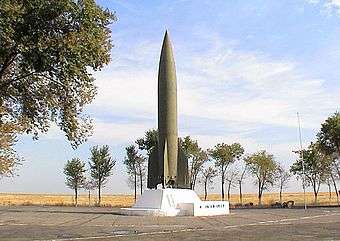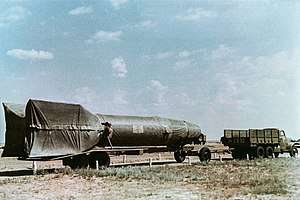R-1 (missile)
The R-1 rocket (NATO reporting name SS-1 Scunner, Soviet code name SA11, GRAU index 8A11) was a tactical ballistic missile manufactured in the Soviet Union based on the German V-2 rocket.[2] Even though it was a copy, it was manufactured using Soviet industrial plants and gave the Soviets valuable experience which later enabled the USSR to construct its own much more capable rockets. The R-1 missile system entered into service in the Soviet Army on 28 November 1950.
| R-1 | |
|---|---|
 Replica R-1 at Znamensk City | |
| Type | Tactical ballistic missile |
| Place of origin | USSR |
| Production history | |
| Manufacturer | OKB-586 (Dnepropetrovsk) [1] |
| Produced | May 10, 1951 [1] |
| Specifications | |
| Mass | 13,430 kg (29,610 lb)[2] |
| Length | 14 m (45 ft 11 in) |
| Diameter | 1.65 m (5 ft 5 in) |
| Engine | Liquid rocket engine 27,200 kgf (267,000 N; 60,000 lbf)[2] |
| Wingspan | 3.56 m (11 ft 8 in) |
| Propellant |
|
Operational range | 270 km (170 mi)[2] |
History
In 1945 the Soviets captured several key V-2 rocket production facilities, and also gained the services of some German scientists and engineers related to the project. In particular the Soviets gained control of the main V-2 manufacturing facility at Nordhausen, and had 30 V-2 missiles assembled there by September 1946.
In October 1946 the Soviets transferred the German missile engineers working for them to a special research facility near Moscow, where they were forced to remain until the mid-1950s. The Soviets established a missile design bureau of their own (OKB-1), under the direction of Sergei Korolev. This team was directed to create a Soviet capability to build missiles, starting with a Soviet copy of the German V-2 and moving to more advanced, Soviet-designed missiles in the near future.[3]
Description

In April 1947 Stalin authorised the production of the R-1 missile, the designation for the Soviet copy of V-2.[4] The first tests of the missile began in September 1948. The system was accepted by the Soviet army in November 1950. The R-1 missile could carry a 785-kilogram (1,731 lb) warhead of conventional explosive to a maximum range of 270 kilometres (170 mi), with an accuracy of about 5 kilometres (3.1 mi).[5]

The first V-2 rocket was transported to the Kapustin Yar test site and launched on 18 October 1947. It flew 206.7 km and deviated left for 30 km.[6] The R-1A was tested, a variant with a separable warhead later in 1947.
High-altitude scientific experiments were conducted with two of the R-1As, and later a series of specialized scientific rockets were built on the basis of the R-1: The R-1B, R-1V, R-1D and R-1E. These carried dogs, and experiments to analyze the upper atmosphere, measure cosmic rays and take far-UV spectra of the Sun.
The R-1 missile system entered into service in the Soviet Army on 28 November 1950.[7][8]
The R-1's insulated electrical wiring attracted vermin. In one January 1953 incident, thousands of flood-displaced mice disabled many rockets by eating the insulation, requiring "hundreds of cats and repairmen".[9]:116
References
- Kudryashov, V. A. Baikonur cosmodrome: Chronicle of the main events (Baikonur Chronicle). Yandex.
- "РКК "Энергия" - История" [Rocket R-1 – Combat missile systems]. www.energia.ru.
- Ivkin, Vladimir (May 2006). "Решение На Прорыв - Постановление Совмина CCCP От 13 Мая 1946 Г. Стало Ключевым Для Развития Ракетостроения" [The decision on the breakthrough - the resolution of the USSR Council of Decisions from may 13, 1946 became the key for the development of the rocket]. VPK (in Russian). 19 (135). Archived from the original on 2008-03-25.
- Wade, Marc. "R1". Encyclopedia Astronautica. Archived from the original on 2012-09-22. Retrieved 2020-04-19.
- Zak, Anatoly (May 18, 2016). "R-1 rocket". RussianSpaceWeb.com.
- "Kapustin Yar". structure.mil.ru. 2006. Retrieved 2020-04-19.
- Zaloga, Steven J. (20 March 2013). V-2 Ballistic Missile 1942–52. Bloomsbury Publishing. p. 41. ISBN 978-1-4728-0299-6.
- Zaloga, Steven J. (20 March 2013). "R-11: the Scud A". Scud Ballistic Missile and Launch Systems 1955–2005. Bloomsbury Publishing. pp. 6–15. ISBN 978-1-4728-0306-1.
- Siddiqi, Asif A. Challenge To Apollo: The Soviet Union and the Space Race, 1945–1974. NASA.
Further reading
- Naimark, Norman (1995). The Russians in Germany. Harvard University Press. ISBN 978-0-674-78405-5.
- Kurt, Magnus (1999). Raketensklaven. Deutsche Forscher hinter rotem Stacheldraht. Elbe-Dnjepr-Verlag. ISBN 3-933395-67-4.